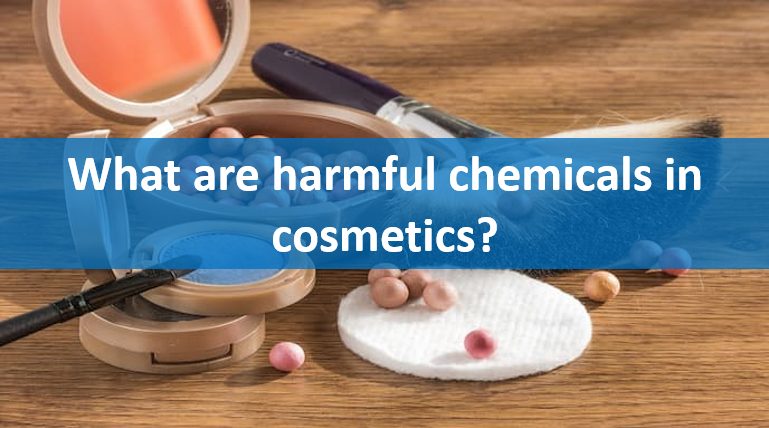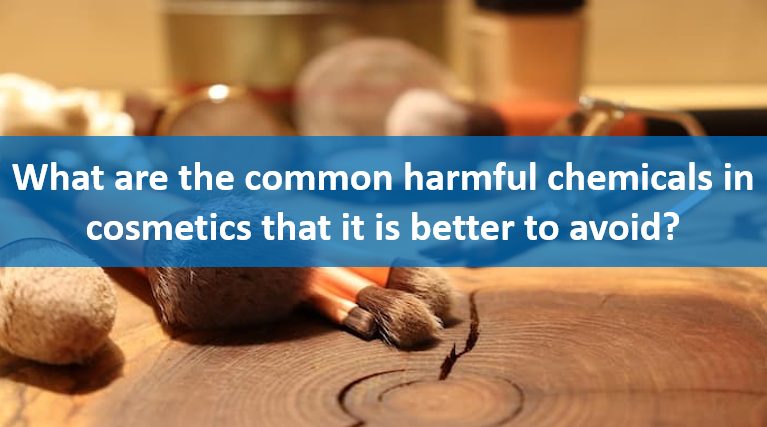
- HOME
- Cosmetic OEM Lab
What are harmful chemicals in cosmetics.
Are chemicals in cosmetics really harmful?
What are the reasons for using harmful chemicals in cosmetics?
The world of cosmetics is vast, offering countless products designed to enhance beauty, improve skin health, and boost confidence. However, hidden beneath the allure of sleek packaging and enticing claims lies a troubling reality: many cosmetic products contain harmful chemicals that can pose risks to your health. In this article, we’ll delve into the world of harmful chemicals in cosmetics, why they are used, and why it’s crucial to be aware of them.
Contents

Harmful chemicals in cosmetics refer to substances used in the formulation of beauty and personal care products that can have adverse effects on human health. These chemicals can range from preservatives and fragrances to colorants and other synthetic compounds. While they may serve a functional purpose in enhancing the product’s texture, scent, or shelf life, they can also cause skin irritation, hormonal disruption, and even long-term health issues like cancer. (Reference: Cosmetic ingredients)
Chemicals are often used in cosmetics for several reasons. They can act as preservatives, preventing the growth of bacteria and mold, thereby extending the product’s shelf life. They may also enhance the texture, spreadability, and overall performance of the product. For example, silicones are commonly used in skincare and makeup products to create a smooth, silky feel and improve the product’s application. Fragrances are added to make products more appealing to consumers, while colorants are used to create visually attractive products. (Reference: European Commission – Cosmetic Products)
Despite their functional benefits, harmful chemicals in cosmetics should be avoided due to their potential health risks. Prolonged exposure to toxic substances like parabens and phthalates can lead to hormone disruption, which can have cascading effects on the body’s endocrine system. Furthermore, certain chemicals like formaldehyde and its releasers have been classified as carcinogens, posing a risk of cancer with long-term exposure. Avoiding these harmful substances is crucial to protect your health and well-being.
Not all chemicals in cosmetics are bad. Many chemicals are safe, effective, and necessary for the product’s function and stability. For instance, water, glycerine, and certain fatty acids are commonly used in cosmetics and are safe for use. The key is to differentiate between harmful and safe chemicals and to be aware of the potential risks associated with specific toxic substances.

In the formulation and production of cosmetics, certain ingredients are added to ensure the product’s feel and shelf life. However, some preservatives can burden the skin and make it more sensitive. So, what ingredients should we try to avoid during the development of cosmetics?
Butylated hydroxyanisole (BHA) and butylated hydroxytoluene (BHT) are synthetic antioxidants commonly used in cosmetics as preservatives. These chemicals help prevent the oxidation of products, thus extending their shelf life. However, BHA and BHT are also linked to potential health risks, including endocrine disruption and carcinogenicity. The International Agency for Research on Cancer (IARC) has classified BHA as a possible human carcinogen. Due to these concerns, it’s advisable to avoid products containing these chemicals.
Formaldehyde releasers, such as DMDM hydantoin and quaternium-15, are used in cosmetics as preservatives to prevent microbial growth. However, formaldehyde is a known carcinogen, and its release from these preservatives poses a significant health risk. Exposure to formaldehyde can cause skin irritation, allergic reactions, and, with long-term exposure, an increased risk of cancer. It’s recommended to avoid products containing formaldehyde releasers, especially if you have sensitive skin.
Parabens are a group of synthetic preservatives widely used in cosmetics to prevent the growth of harmful bacteria and mold. Common parabens include methylparaben, propylparaben, and butylparaben. However, parabens have been found to mimic Estrogen in the body, leading to hormonal imbalances and potential reproductive harm. They have also been detected in breast cancer tissues, raising concerns about their role in the development of cancer. Although more research is needed, it’s prudent to choose paraben-free products when possible.
Polyethylene glycols (PEGs) are commonly used in cosmetics as emulsifiers, thickeners, and skin conditioning agents. While PEGs themselves are not considered highly toxic, they can be contaminated with harmful substances like ethylene oxide and 1,4-dioxane, both of which are known carcinogens. Additionally, PEGs can enhance the absorption of other harmful chemicals into the skin, potentially increasing the risk of adverse health effects. It’s advisable to avoid products with PEGs, especially if they are likely to be contaminated.
Sodium Laureth Sulfate (SLES) is a surfactant used in many cosmetics, especially in shampoos, body washes, and facial cleansers, to create a foaming effect. While SLES is effective in removing dirt and oil, it can also strip the skin of its natural oils, leading to dryness and irritation. Moreover, SLES can be contaminated with 1,4-dioxane, a potential carcinogen, during the manufacturing process. To minimize these risks, opt for sulfate-free products that are gentler on the skin.
Silicones, such as Dimethicone and Cyclopentasiloxane, are used in cosmetics to provide a smooth, silky texture and improve the application of products. While silicones are not inherently toxic, they can create a barrier on the skin that traps dirt, oil, and other impurities, potentially leading to clogged pores and breakouts. Additionally, silicones are not biodegradable, raising environmental concerns. For those with sensitive or acne-prone skin, it’s best to avoid products containing silicones and opt for more breathable alternatives. (Reference: PubMed – Silicones in Cosmetics)
Preservatives are essential in cosmetics to prevent the growth of harmful bacteria, mold, and yeast, which can compromise the safety and efficacy of the product. However, not all preservatives are created equal, and some can be more harmful than others. While certain preservatives, like parabens and formaldehyde releasers, pose health risks, others, like phenoxyethanol and potassium sorbate, are considered safer alternatives. The key is to choose products that use gentle, non-toxic preservatives and to be aware of any potential sensitivities or allergies you may have to specific ingredients. (Reference: Preservatives in Cosmetics)

The cosmetics industry is filled with products that promise beauty and wellness, but it’s essential to be an informed consumer when it comes to the ingredients used in these products. Harmful chemicals like BHA, formaldehyde releasers, parabens, PEGs, sodium Laureth Sulfate, and silicones can pose significant health risks, from skin irritation and hormone disruption to potential cancer risks. While not all chemicals in cosmetics are harmful, it’s crucial to understand the risks associated with specific toxic substances and to make informed choices about the products you use.
In the pursuit of beauty, it’s worth taking the time to read labels, research ingredients, and choose products that prioritize your health and well-being. By opting for cosmetics that are free from harmful chemicals, you can enjoy the benefits of beauty without compromising your health.
For further information, please contact us.